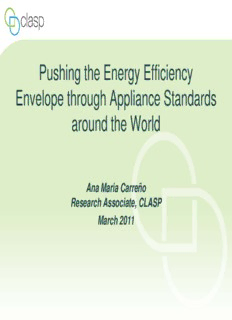
Pushing the Energy Efficiency Envelope through Appliance Standards around the World PDF
Preview Pushing the Energy Efficiency Envelope through Appliance Standards around the World
Pushing the Energy Efficiency Envelope through Appliance Standards around the World Ana Maria Carreño Research Associate, CLASP March 2011 Today over 75 countries with more than 80% of the world's population have energy standards & labeling EFRNIdeOCelaMtecIirE-óm0n2Ni nd1ae-Cd EEaN fIciAcEoiemR noE/cS isaNCe E FenEsIe/tEarRgbCélGetOiccLeaÉ -e(2RnT0 El0aIEC0)A REE= EfectPoo nteetnoc idae e eléncfrtiraicmai e(Wnt)o (W) PMoatrecnac:iaS eUlPécEtRric-IaR:I8S60 WEMfeocdteol on:etToG dVe0 e2n4fRria2m00ieBnto:17 000 W REE establecida en la norma en ( W/W ) 2,49 REE de este aparato en ( W/W ) Ahorro de energía de este aparato AMhe0on%rororEh5la% sasehtagoE urqLrrs1uoaitd0e e dae% ehaddtip aeq eaay unula1 reuesa5 tsosIrat%goMiu dyn íacao olrPu oi ea2omdcf0Od eeayp%qbcl liRunezteiioav rcrTi oc2dedoi 5Aoótandi%r nñ epalN oapodrss ereTl3e a nrle0 edEadc%l qepaceuroaplá inraas3 adisp 5tdtouea%oems rl ao oditds4zoe o0oh %rná fobinit4ao5lsA%Mhao5y0ror%or CLASP: Global Expertise on Energy Efficiency Standards & Labeling The Collaborative Labeling and Appliance Standards Program’s (CLASP) primary objective is to identify and respond to the assistance needs of S&L practitioners around the world while making the highest quality technical information on S&L best practice available globally. • Established in 1999 by the Alliance to Save Energy, International Institute for Energy Conservation, and Lawrence Berkeley National Laboratory. • Became a ClimateWorks Foundation Best Practice Network (BPN) in March of 2009. • Formerly a small, distributed network of international experts, CLASP has expanded and matured with over 23 full time team members in 4 offices (Beijing, Brussels, DC, and Delhi . Current & Former Country Scope CLASP has provided S&L technical assistance in over 50 countries on 6 continents, including Australia, Brazil, Egypt, Fiji, Ghana, Korea, Poland, South Africa, Thailand, Tunisia, Uruguay, and Vietnam. Under support from the ClimateWorks Foundation, CLASP currently provides technical support in: • China • European Union • India • Mexico • United States • Global Research Projects CLASP works in additional countries and regions pending funding and opportunity, and taking into account the global potential and country priorities. CLASP Core Services For maximum impacts, CLASP: • Provides technical assistance and expertise to national governments and other stakeholders including: • Product Specific Technical Analysis • Market Impacts Studies • Label design research • S&L Impacts Assessment • Product Prioritization Studies • Program Evaluation • Assembles and oversees project teams from diverse and highly-qualified organizations • Disseminates best practice information and training • Guidebooks on Best Practice S&L and Compliance • Studies on Harmonization and Product Benchmarking • Regulatory Agenda Tracking CLASP’s Funders Market Transformation Standards and labs work together to push and pull the market toward greater energy efficiency. Standards and Labeling Programs Impact the Environment Reducing the energy consumption of a product On aggregate, reduces overall energy consumption Which, reduces power demand Which, reduces the need for the production of electricity Therefore, reducing And, increasing the green house gas feasibility of renewable emissions and other pollutants Reasons for Implementing Standards and Labeling Programs Countries adopt standards and labeling policy for a number or reasons 1. Reduce capital investment in the energy supply infrastructure a) Less expensive then energy production b) Makes renewable energy more affordable by reducing the need for energy production 2. Avert urban/regional pollution 3. Promote competitiveness of domestic manufacturers by avoiding non-tariff trade barriers 4. Secure energy independence 5. Meet climate change goals Building Technology Efficiency Most Cost Effective Source: American Physical Society, September, 2008 http://www.aps.org/energyefficiencyreport/report/aps-energyreport.pdf
Description: